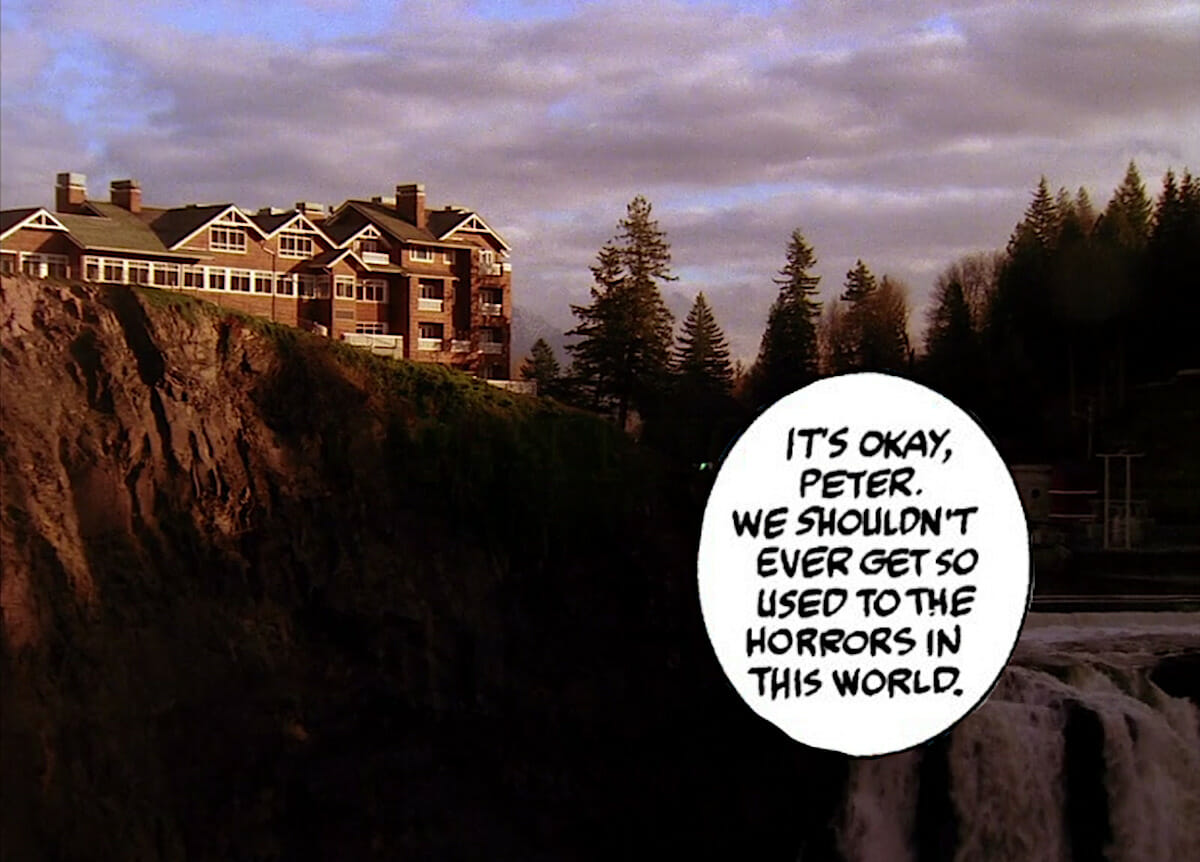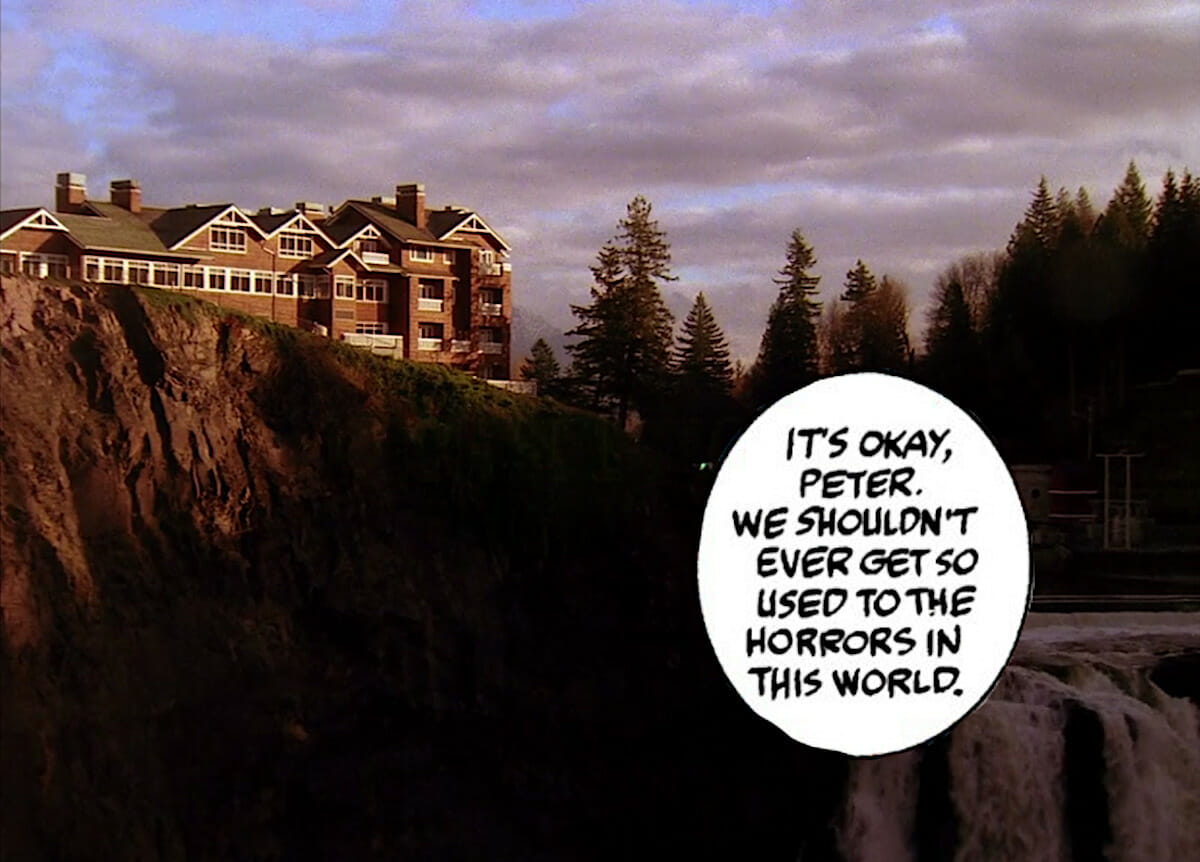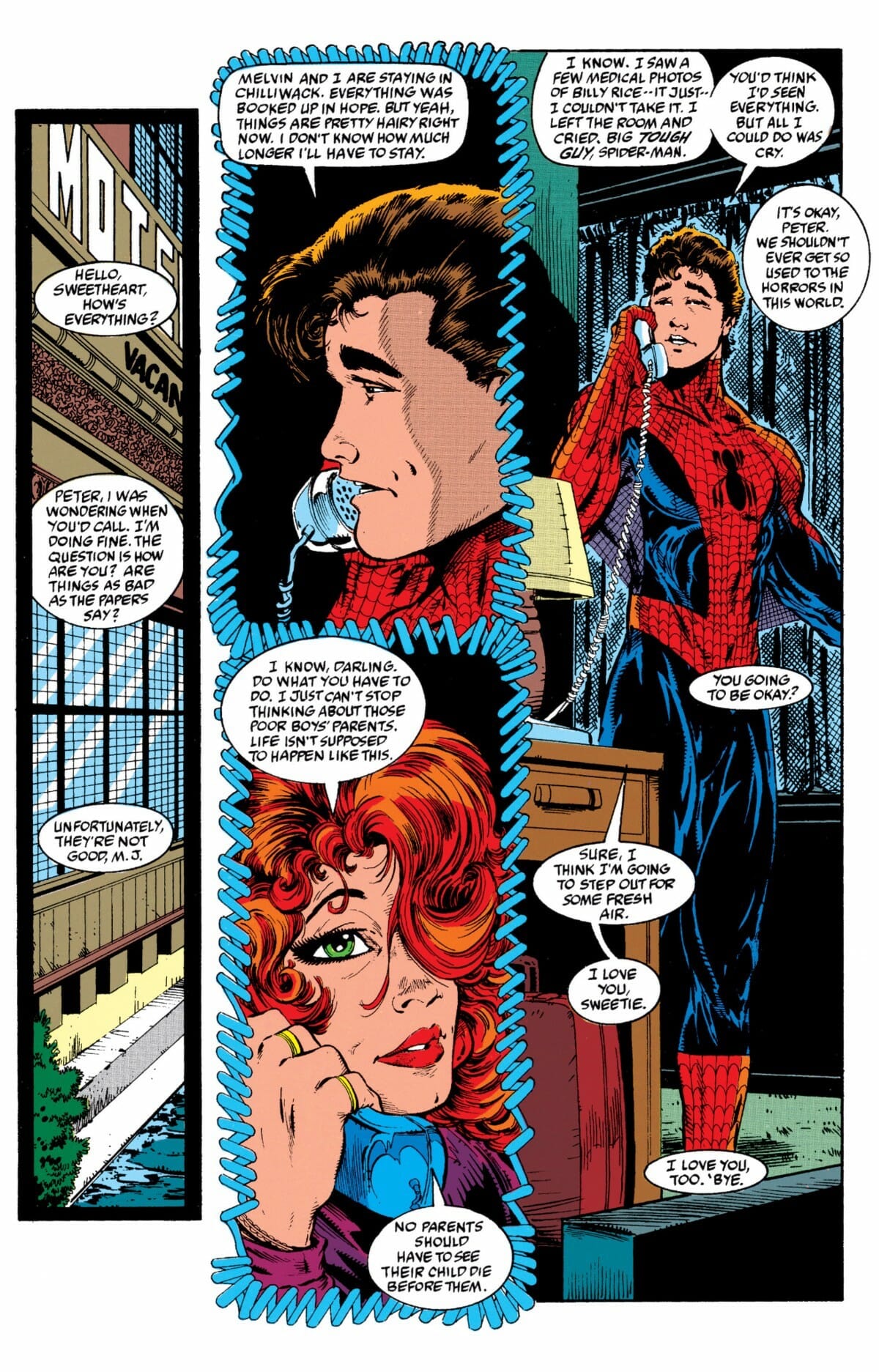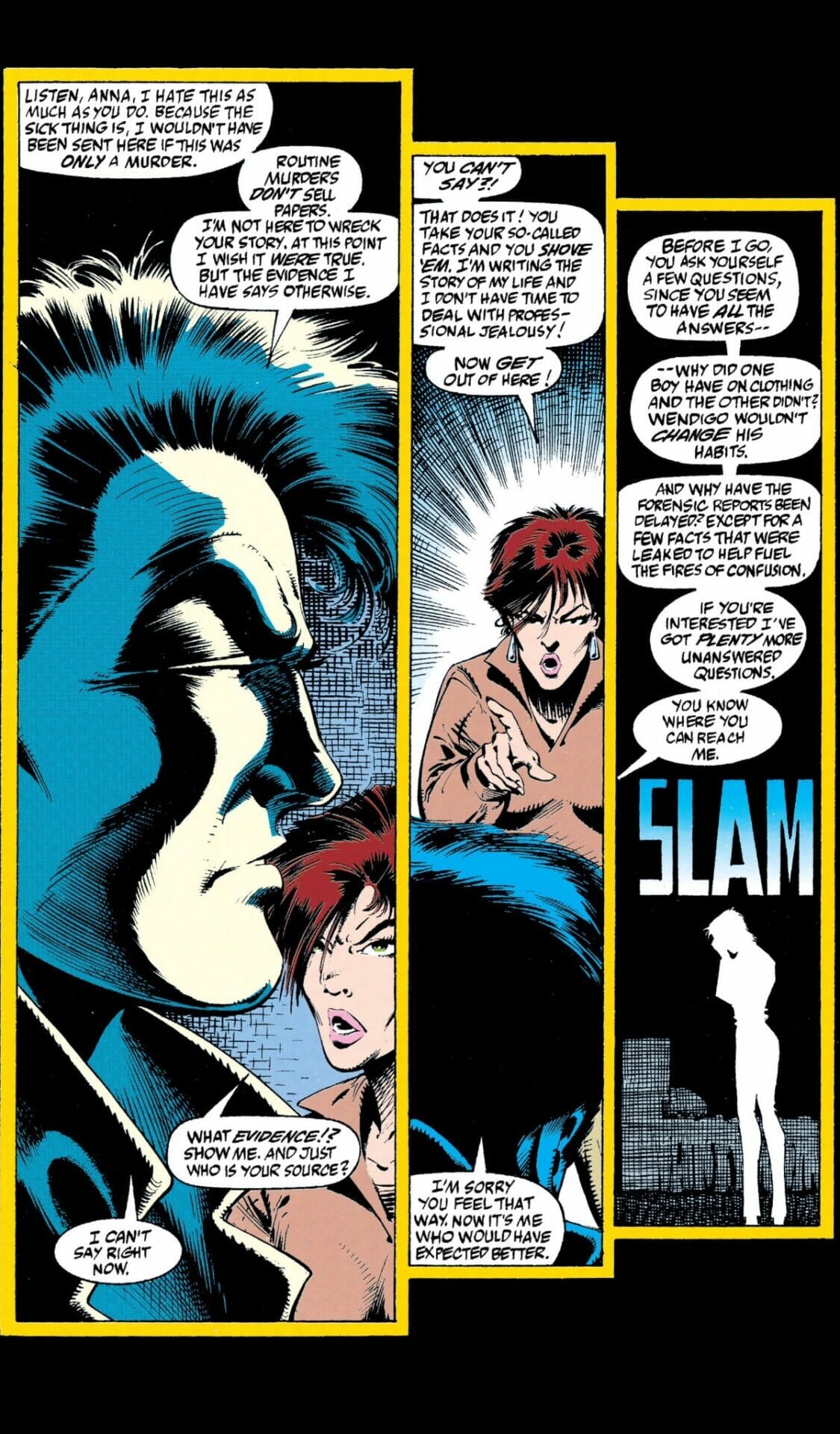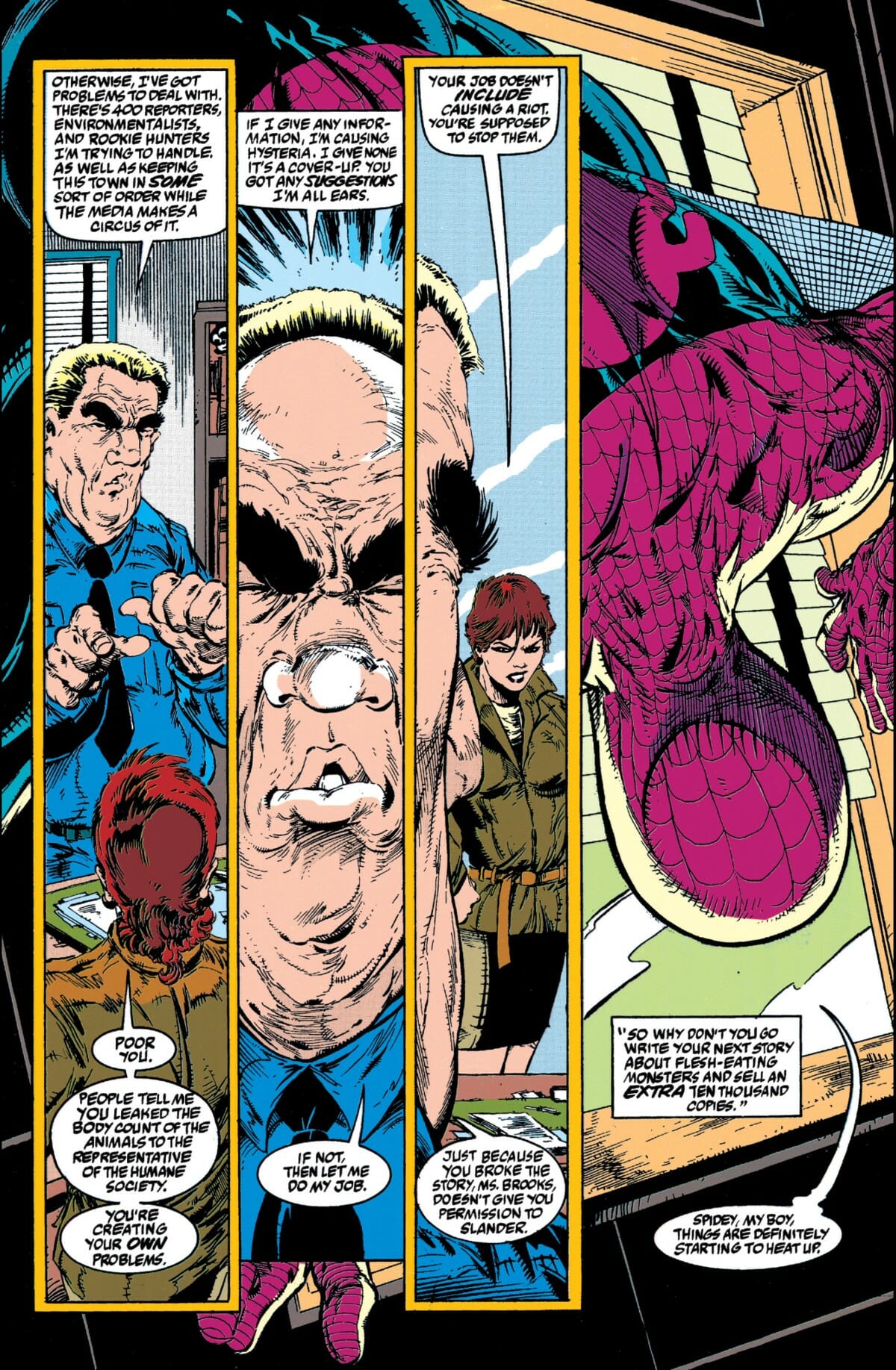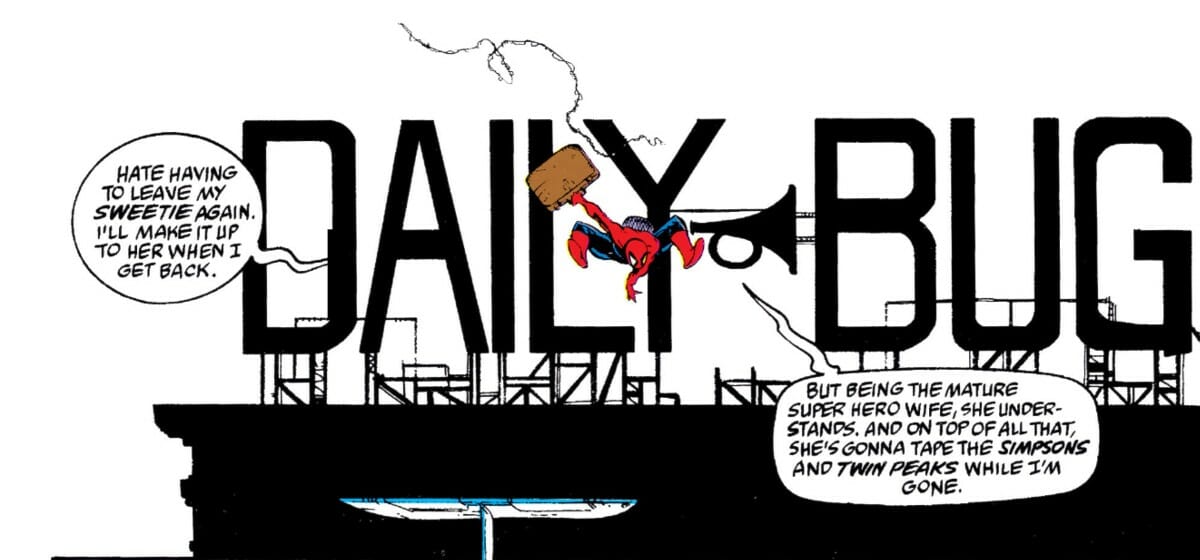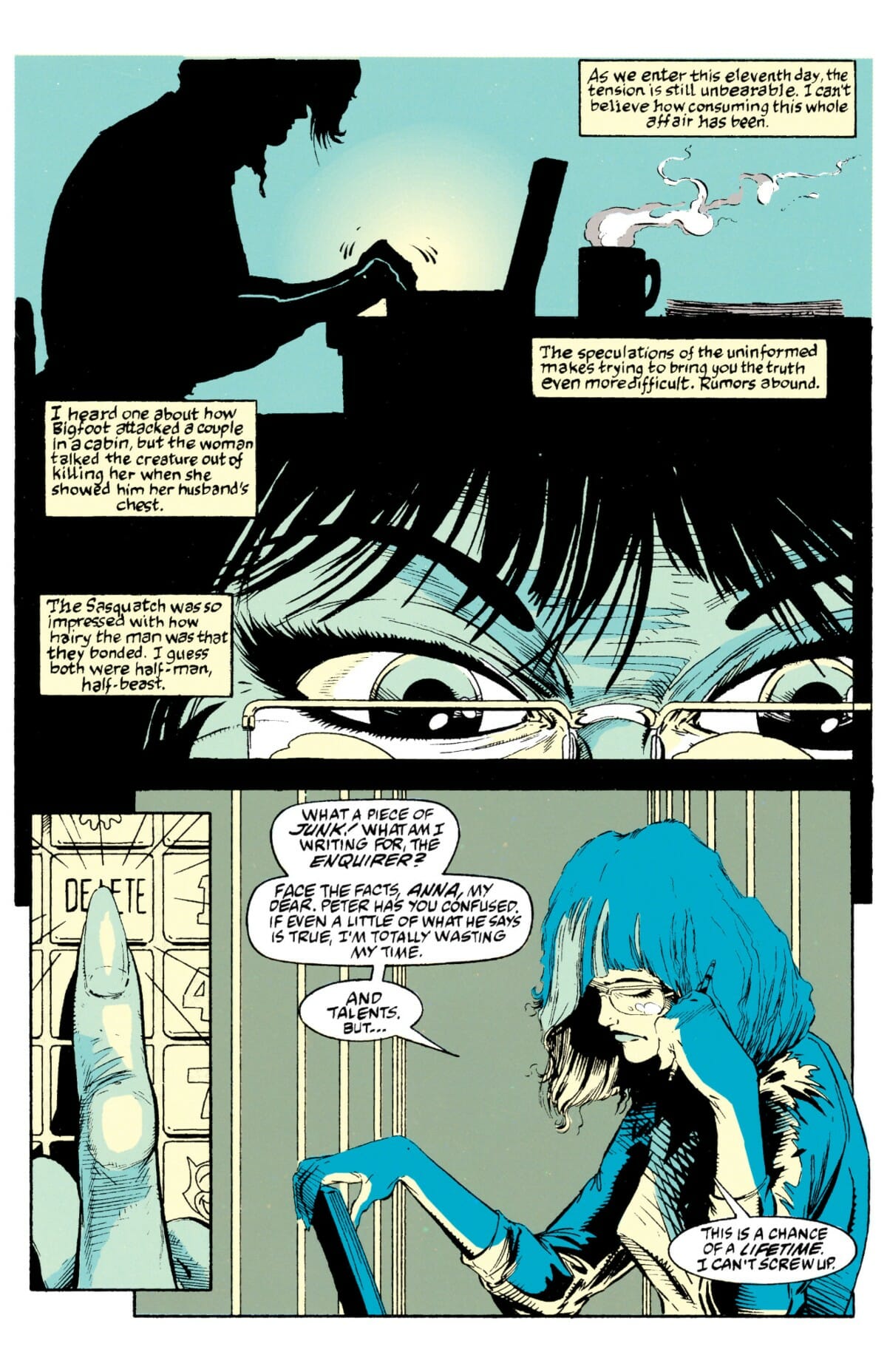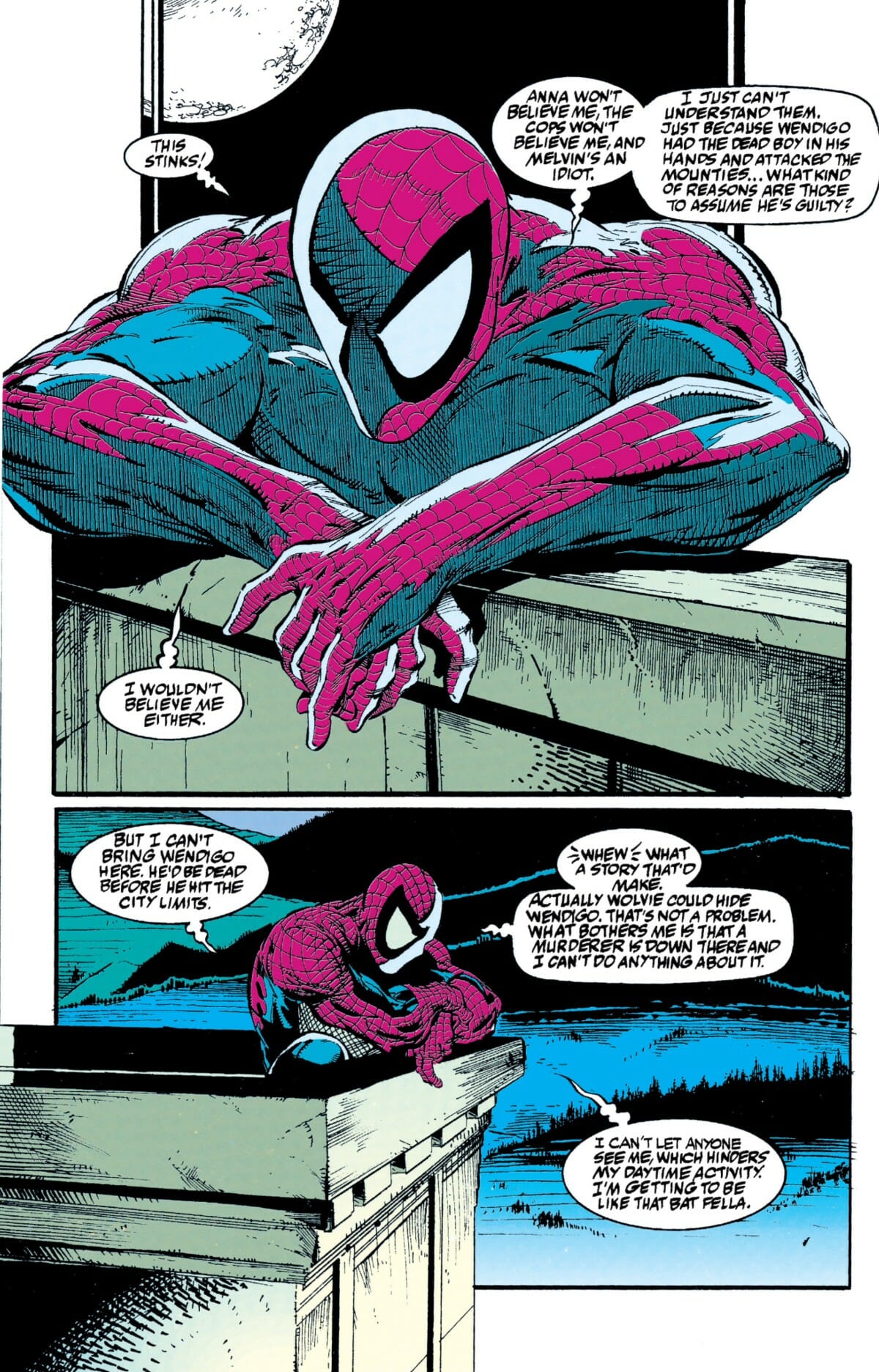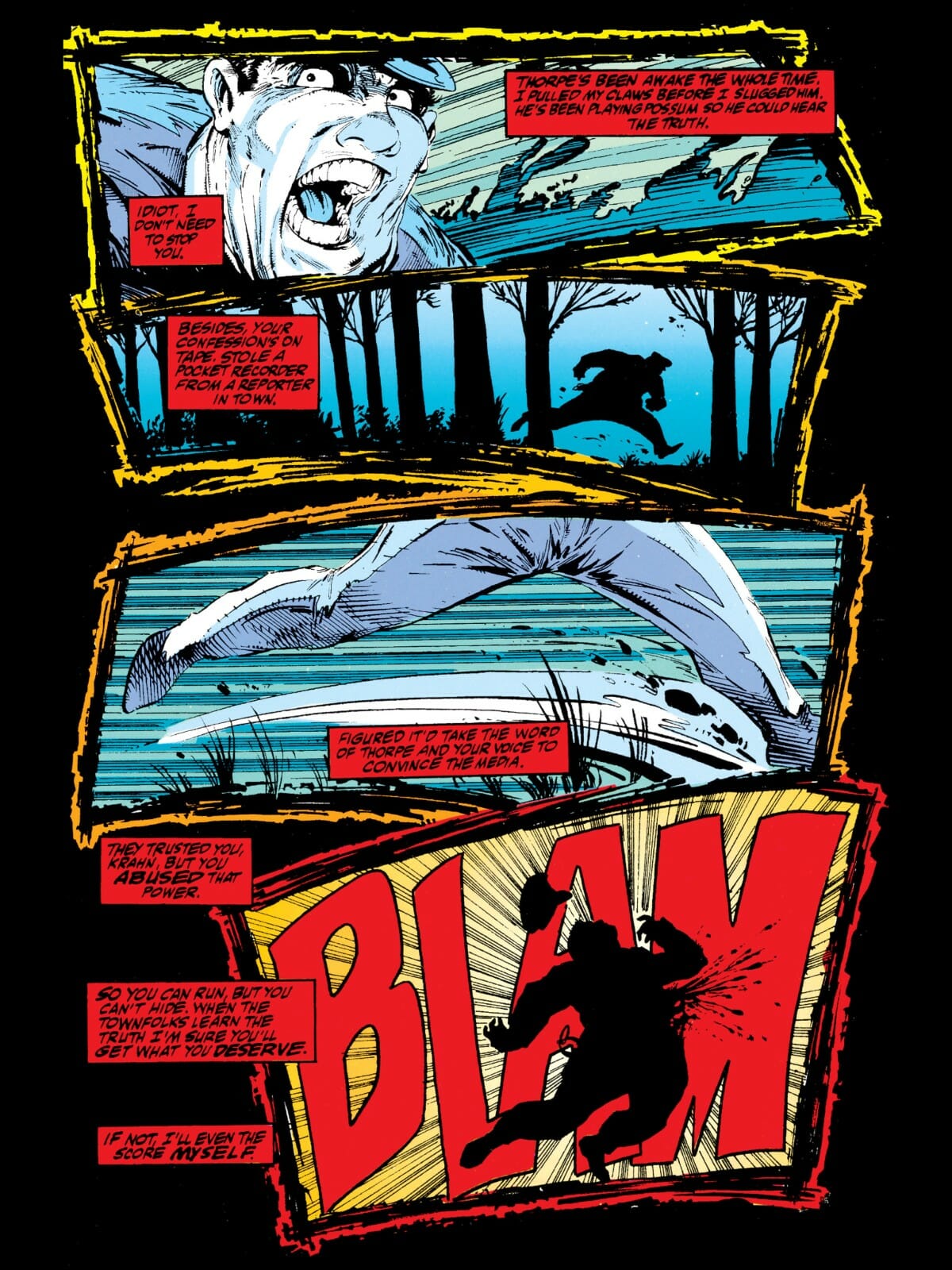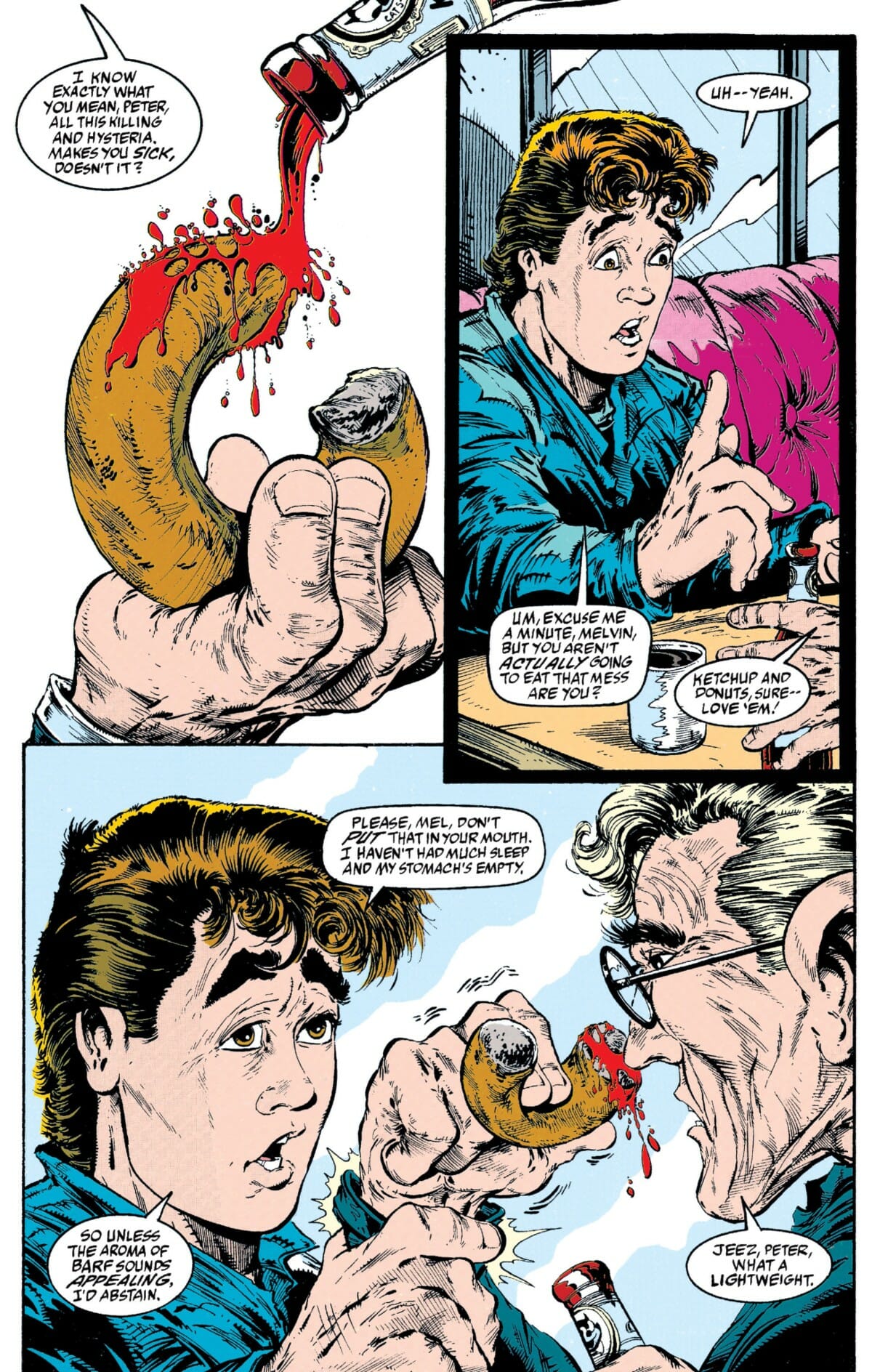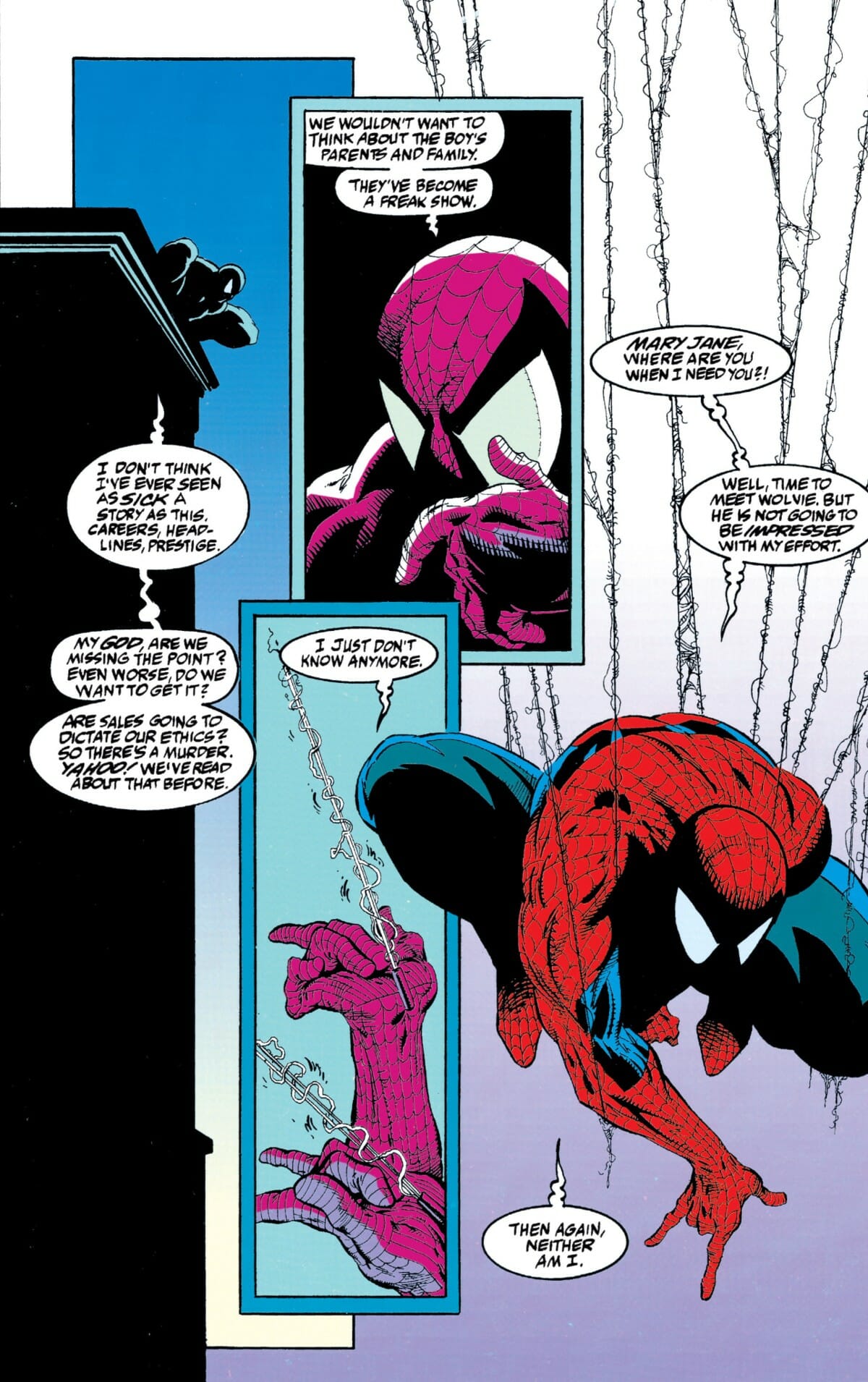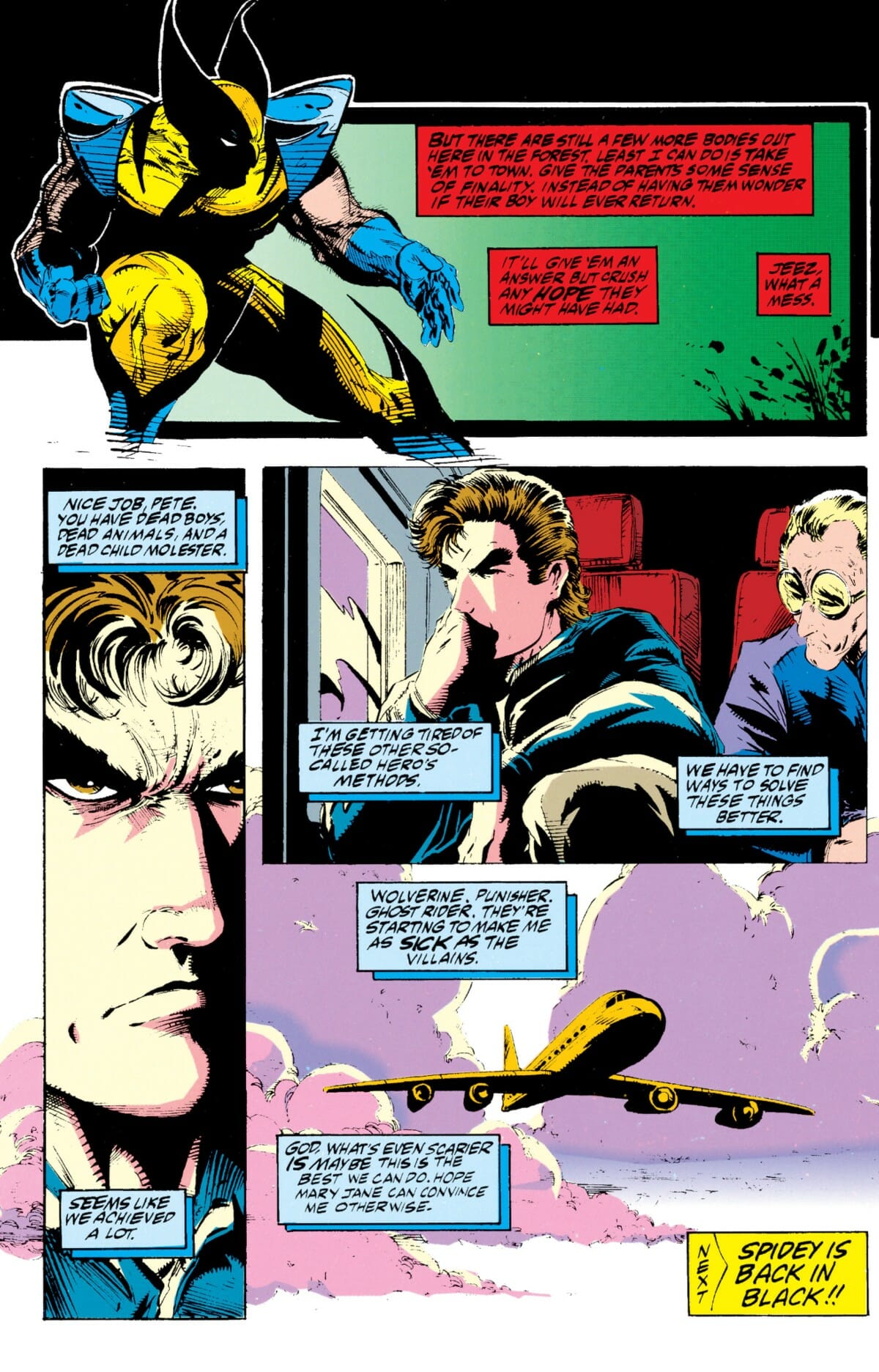From March to July of 1991, Marvel Comics published a story titled “Perceptions” in their adjective free Spider-Man comic. That first year of Spider-Man was illustrated and written by Image co-founder and Spawn creator Todd McFarlane, who’d made a name for himself as a brilliant artist and a learning-as-he-went writer. “Perceptions” was the longest and most ambitious story he told during that run, a bleak, sobering tale about the witty webslinger traveling up to Canada to solve a horrific murder. Out of all the stories McFarlane told in Spider-Man, “Perceptions” is the one that has stuck with me, for the moments where it clicks, the moments where it falters, and the tremendous debt it owes to a certain television show about a place both wonderful and strange.
The tale kicks off, appropriately enough, with someone seeing something they weren’t expecting to see. In the town of Hope, British Columbia, a reporter named Anna Brooks narrowly survives a horrific wreck when her car collides with a mysterious creature. As Anna stumbles clear of her ruined vehicle, the creature flees, leaving her to discover the mutilated body of a dead boy. His name was David Neusel, and he was not the first boy to have gone missing in the area. Thanks to Anna’s encounter, the disappearances at last have an explanation. Something is killing the children.
The press and the public want to know more—or perhaps they’re just bloodthirsty. The RCMP are simultaneously frantic and bizarrely lackadaisical in their approach to the investigation. Roving bands of gun-toting schmucks want to vaporize any animal they see, and animal rights activists aren’t having that. The spiral grows teeth, and soon the stage is set for a cornucopia of collective maimings: emotional, moral, and physical.
Enter two outsiders, men who possess clear eyes and extraordinary abilities. Peter Parker —ace photographer and friendly neighborhood Spider-Man —and Logan, the one-time living weapon and X-Man called Wolverine. Peter, on assignment for the Daily Bugle, wants to unearth the truth behind the killings. Logan, back in his home country, wants the wanton killing of innocent wildlife to stop and save an innocent Wendigo, who’s being scapegoated for the murders. Despite their often-prickly relationship, the two heroes join forces to solve the horrific mystery that’s driving Hope to eat itself alive.
The truth the ultimately discover leaves Logan grimly resigned to his cynicism and Peter embittered and uncertain of whether he was able to do any sort of good at all.
“Perceptions” is a fascinating, if not wholly successful, comic. After kicking off Spider-Man with “Torment”, a story that played to his strengths as an artist and writer (visual emphasis on Spider-Man in motion, horror beats built on the grotesque and the mystical) McFarlane takes a genuine swing and tries to stretch himself. “Perceptions” is a mystery that questions society’s systems of power, a horror story where the supernatural is less terrifying than the domestic/familiar, and to some extent a deconstructive presentation of Spider-Man.
Most intriguing of all, “Perceptions” is, deliberately or otherwise, deeply influenced by and riffing on David Lynch, Mark Frost, and company’s once-beloved-then-discounted-now-again-beloved and highly influential supernatural mystery/horror/slice of life television series Twin Peaks. “Perceptions” original 1991 run overlapped with the end of Twin Peaks’ original run – “Perceptions” wrapped in July, and Twin Peaks in June of that year. Given the time it takes to create a comic, McFarlane worked on “Perceptions” during Twin Peaks’ first run.
Indeed, the first issue of “Perceptions” outright mentions the show by name. Spidey, on his way to the airport after being dragooned into covering the murders by J. Jonah Jameson, muses on the ever-present challenge of balancing his super-heroism with his personal and professional lives:
“Hate having to leave my sweetie again. I’ll make it up to her when I get back. But being the mature super hero wife, she understands. And on top of all that, she’s gonna tape the Simpsons and Twin Peaks while I’m gone.”
With that invocation, the numerous ways in which “Perceptions” echoes Twin Peaks—specifically the Laura Palmer murder arc—become clear. A horrendous crime rocks a town filled with secrets. An eccentric and honorable investigator arrives from out of town. The investigator meets both acceptance and resistance from different players. He gains a major ally who’s bitter, unpleasant, and deeply good-hearted. His investigation takes him deep into the woods, where the barrier between the known world and the mystical is thin.
When the mystery is at last solved, the solution reveals the responsible to be a whole different sort of horrifying from a rampaging demon. The investigator and his allies are left to ponder morality and their comprehension of evil.
What makes the intersection between “Perceptions” and Twin Peaks so fascinating is the way McFarlane’s storytelling both clicks and clashes with the work of Lynch, Frost, and company. The debt McFarlane’s comic owes to Twin Peaks is deep, but his aesthetic sensibilities, genre of choice, and storytelling medium lead to a work that is, for ill and good, very much itself—even when the echoes are particularly strong.
Both the Twin Peaks team and McFarlane are fascinated by the difference between perception/projection and reality—and the grotesqueries that can result from such dissonance. Leland Palmer appears a grieving and loving, if manic, father when he is in truth Laura’s rapist and murderer. RCMP Inspector Krahn plays the diligent Mountie at his wit’s end trying to catch a child killer, when in truth he’s a murderer and pedophile.
Part of what makes Palmer and Krahn’s crimes so appalling is the mockery they make of the trust others put in them. Leland is Laura’s father. Krahn is a public servant. They betray the moral charges that should in theory come with these roles, and in so doing twist them into something monstrous.
But where Lynch, Frost and company braided Twin Peaks’ horrible secrets together with moments of warmth and loveliness, McFarlane opts for near-constant viciousness. Twin Peaks’ Dale Cooper swiftly wins the friendship and trust of many in town, a band that, while eccentric, contains more than its share of deeply good people. “Perceptions” surrounds Spider-Man with a host of venal schmucks.
“Perceptions”’ supporting cast’s behavior ranges from moral cowardice (Anna Brooks, who can’t let go of the story that might be her big break even as its holes become increasingly frayed) to oily smarm (fellow Daily Bugle reporter Melvin) to being a murderous pedophilic rapist (Krahn). Even Wolverine, Spidey’s one reliable ally, is (being Wolverine) a surly, misanthropic grump.
The sole exception to this is Mary Jane Watson-Parker, Peter’s wife, but there’s only so much that she can do from New York.
McFarlane’s focus on the horrible and the grotesque extends to “Perceptions” visuals, resulting in another fascinating parallel with Twin Peaks. Acknowledging the distinctions between film visuals and comics visuals, both are works that draw a response from horrifying imagery.
Twin Peaks cultivates its horror in part by twisting familiar, often welcoming imagery into something dreadful—i.e., the Palmers’ homey living room (creepy Renoir clown painting and all) and all, becoming the site of Leland/BOB’s laughter and tear-filled murder of Maddie Ferguson.
“Perceptions”, while limited by the Comics Code Authority, opts for a more direct approach, especially with regards to the cast’s faces. McFarlane makes wrath, contempt, and fear look deeply ugly. His players’ expressions swallow them up, distorting their features to reveal their current truth. It’s consistently unsettling. Taken in concert with the tale’s bleakness, in the context of McFarlane’s career, “Perceptions”, and by extension this Spider-Man run as a whole, reads like a dry run for his later horror/super-hero work on Spawn.
Indeed, the sheer overwhelming bleakness and grime of Peter Parker’s time in Canada extends to the food. Twin Peaks famously spotlighted delectable looking coffee and pie. “Perceptions” devotes an extended close up to a donut being smothered in ketchup (accomplishing the impressive feat of making the ill-conceived Roscoe’s Chili and Donuts look appetizing), much to Spidey’s relatable nausea.
“Perceptions”’ parallels to Twin Peaks are most interesting when the book’s super-heroic mode becomes a factor. Spider-Man is New York’s great champion. He knows the city, and he loves it as much as he loves Mary Jane. In New York, there are few who can match him.
But British Columbia is a long way from New York. Outside of Wolverine, Spider-Man has no allies. And he cannot operate in the open for fear of someone drawing a line between the famous New York hero and the well-regarded photojournalist Peter Parker, currently in town to cover the ongoing murders and their fallout. Peter fares little better, being dismissed as a Yankee by the locals, ignored by the Mounties, and cursed as a jealous rival by Anna Brooks.
Where Dale Cooper gathered allies and led the investigation into Laura Palmer’s demise, keeping on the ball even amidst the increasing supernatural presence, Peter Parker is left to do what he can to stop the killings and protect the Wendigo. Though Cooper fails during the course of the Laura Palmer arc (most dramatically when he fails to uncover Leland/BOB’s identity before he strikes again) and will fail again in the later parts of Twin Peaks he closes the arc accepting that evil can and must be fought and has attained a degree of closure.
Peter is not so fortunate. Whether as himself or as Spider-Man, he proves almost completely ineffectual when removed from his comfort zone. He ultimately has to let Logan take the lead, a move which leaves him rattled by the older man’s ruthlessness. Coming on the heels of a fraught encounter with Ghost Rider, Spidey’s journey in “Perceptions” ends with him ruminating on his frustration at recent events.
“Nice job, Pete. You have dead boys, dead animals, and a dead child molester. Seems like we achieved a lot. I’m getting tired of these other so-called hero’s methods. We have to find ways to solve these better. Wolverine. Punisher. Ghost Rider. They’re starting to make me as sick as the villains. God, what’s even scarier is maybe this is the best we can do. Hope Mary Jane can convince me otherwise.”
The form and structure of a 1990 superhero comic can accommodate a mystery as bleak as “Perceptions” attempts to be to a degree, but it has limits. “Perceptions” tilts so far into the darkness that super-heroism fails, and it’s easy to imagine an alternate take on the story where, perhaps in territory he knows, Spider-Man is able to prevent at least one of the killings and bring down the man responsible without his getting shot by the very people he whipped into a frenzy to cover his tracks. But in the work as published, Peter is left to brood.
“Perceptions”, it must be said, does not wholly work. In 1990, Todd McFarlane was very good at action and mood and had a long way to go in his work with narrative structure—after four issues of marinating in mood, “Perceptions” rushes its finale with oodles of narration and pacing so hurried that it undercuts what could have been a dramatically satisfying resolution. Furthermore, McFarlane’s dialogue is often overly verbose, tripping into outright floridness on occasion. Nevertheless, it’s an intriguing comic. It’s a time capsule, not only of McFarlane’s work at the time, but of the world around it. Fiction is, in one way or another, always in conversation with the time and place it was published in. For “Perceptions”, that’s a world where Twin Peaks was the supernatural mystery, and to tell a supernatural mystery of one’s own was to interact with it on some level. So McFarlane did, and the result was, for better or worse, a lasting impression that was very distinctly his.
